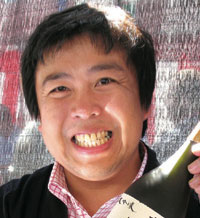Sake Nation “Super Frozen Sake: Part 3”
By Kosuke Kuji
How can I distribute the ultimate, fresh, unpasteurized sake worldwide?
I thought about the answer to this question for the past 10 years.
Unpasteurized sake is of course fresh. Since the sake is unpasteurized, however, enzymes in the sake significantly deteriorate the sake flavor. This stale odor and off-flavor of aged sake is called “nama-hine (ka).”
This reaction will ‘always’ occur, even if sake is stored at ultra-low temperatures such as 23 degrees Fahrenheit or even 14 degrees Fahrenheit, a problem that cannot be solved simply by lowering the storage temperature.
Some sake breweries remove the “enzymes” acting as a buffer between the changes generated to delay the effects of nama-hine (ka). However, removing the enzymes does not eliminate the problem altogether. Also, the equipment to remove the enzymes from sake is quite pricey.
Further, to distribute unpasteurized sake overseas, it must be taken into consideration that foreign importers and restaurant refrigerators are not set to negative temperatures overseas. In other words, no matter how quickly sake breweries release freshly squeezed unpasteurized sake, sustaining the fresh, unpasteurized sake quality year-round would prove difficult.
Although unpasteurized sake is already distributed in the U.S., the flavor has significantly deteriorated compared to unpasteurized sake sold in Japan because of “nama-hine (ka).” On the other hand, sake pasteurized normally and thoroughly by the brewery and in fresh rotation usually tastes better in many cases. Although slightly less fresh compared to unpasteurized sake in the freshest condition possible, in terms of stability of the sake flavor, I thought it was impossible to distribute unpasteurized sake overseas in the freshest condition possible.
I took a private, non-work related trip to Kochi prefecture, where I was blessed with a fateful encounter.
How can I distribute the ultimate, fresh, unpasteurized sake worldwide?
I thought about the answer to this question for the past 10 years.
Unpasteurized sake is of course fresh. Since the sake is unpasteurized, however, enzymes in the sake significantly deteriorate the sake flavor. This stale odor and off-flavor of aged sake is called “nama-hine (ka).”
This reaction will ‘always’ occur, even if sake is stored at ultra-low temperatures such as 23 degrees Fahrenheit or even 14 degrees Fahrenheit, a problem that cannot be solved simply by lowering the storage temperature.
Some sake breweries remove the “enzymes” acting as a buffer between the changes generated to delay the effects of nama-hine (ka). However, removing the enzymes does not eliminate the problem altogether. Also, the equipment to remove the enzymes from sake is quite pricey.
Further, to distribute unpasteurized sake overseas, it must be taken into consideration that foreign importers and restaurant refrigerators are not set to negative temperatures overseas. In other words, no matter how quickly sake breweries release freshly squeezed unpasteurized sake, sustaining the fresh, unpasteurized sake quality year-round would prove difficult.
Although unpasteurized sake is already distributed in the U.S., the flavor has significantly deteriorated compared to unpasteurized sake sold in Japan because of “nama-hine (ka).” On the other hand, sake pasteurized normally and thoroughly by the brewery and in fresh rotation usually tastes better in many cases. Although slightly less fresh compared to unpasteurized sake in the freshest condition possible, in terms of stability of the sake flavor, I thought it was impossible to distribute unpasteurized sake overseas in the freshest condition possible.
I took a private, non-work related trip to Kochi prefecture, where I was blessed with a fateful encounter.
酒豪大陸「日本酒のスーパーフローズン その3」
究極のフレッシュな生酒を世界に流通させられないか。
この10年ほどずっとこれを考えてきました。
生酒はもちろんフレッシュなのですが、その分、殺菌をしていないので、酒の中の酵素が悪さをして酒の味を劇的に変えてしまいます。これを「生ヒネ」といいます。
これはマイナス5度、マイナス10度と超低温の貯蔵でも「必ず」起こる反応で、貯蔵温度を下げるだけでは解決できないのです。
中にはこの生ヒネの変化を起こすバッファーとなっている「酸素」を酒の中から取る事で生ヒネを遅らせる蔵もありますが、完全に無くする事は出来ません。それにその機械はとても高いのです。
さらに、海外で流通となると、海外のインポーターやレストランの冷蔵庫の温度はマイナスではありません。そうなると、蔵でどんなにしぼってすぐのお酒を出しても、それを1年間ずっとフレッシュな状態で売り続ける事は難しくなります。
アメリカなどでは生酒が流通し始めていますが、どうしても日本で飲む生酒と比べると味は生ヒネで落ちており、逆に丁寧な火入れをして、フレッシュローテーションをしている蔵の通常の火入れのお酒の方が酒の味が良い事も多々あります。フレッシュさは生の最高の状態よりも落ちますが、安定、という意味ではやはり海外で生酒を当たり前に最高の状態で流通するのは不可能と考えていました。
そんな中、私は仕事とは別のプライベートの旅行で高知県を訪ねます。ここで奇跡の出会いがありました。




